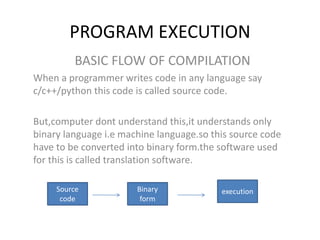
Program execution
- 1. PROGRAM EXECUTION BASIC FLOW OF COMPILATION When a programmer writes code in any language say c/c++/python this code is called source code. But,computer dont understand this,it understands only binary language i.e machine language.so this source code have to be converted into binary form.the software used for this is called translation software. Source code Binary form execution
- 2. TYPES OF TRANSLATION SOFTWARE COMPILER INTERPRETER COMPILER Compiler takes the complete source code and it will convert it into machine code at once. Steps in compilation-: 1)Preprocessing 2)compilation 3)Assembly 4)Linking
- 3. Preprocessing Phase- - removes comments - Imports all the modules - Carries out all the preprocessing directives. Compilation Phase- 1.)analysis Phase- -smallest indivisible unit in a program is called token...eg.keywords,identifiers,literals. -This phase recognizes all the tokens ,and creates a symbol table out of it.
- 4. Synthesis Phase- ==Syntax tree is a tree that represents all the constructs of the source code in the form of a tree. ==Basically all the operators are placed on the root node and the operands are placed on the leaf nodes. ==This phase generates this syntax tree. ==If any error is there ,it will be reported as error. Once the code is error free,it is converted into assemby language code called Intermediate code. Eg-:4*5+9 * + 9 4 5
- 5. Assembly Phase- This phase converts the assembly level instructions to equivalent machine code called object code Linking-all the required libraries are loaded with the help of Linker. Loader-It is a part of compiler that loads all the instruction into memory for execution. COMPLETE COMPILATION PROCESS assembly machine Source code analy sis synth esis Object code libraries Executable
- 6. INTERPRETATION PROCESS ==It analyses each line of code ,converts it into object code ,adds required libraries and runs it. ==The first line of code is executed ,yet before second line of code is converted to object code. WORKING OF INTERPRETER code1 code2 code3 interpreter 10101010 10101101 10110110
- 7. DIFFERENCE BETWEEN COMPILER AND INTERPRETER • COMPILER INTERPRETER • takes entire program - takes single line of code • generates intermediate code - does not generate takes more memory - takes less memory displays the list of errors - display error in single line no,once the work is done,it - always required is no more required INPUT OUTPUT MEMORY ERRORS Always required
- 8. ROLE OF OPERATING SYSTEM IN RUNNING A PROGRAM • OS as a resource manager- A program when not running lies on the disk. To execute it,is loaded into memory then it becomes process ==To manage resources(to improve efficiency) ==When a running process needs I/O ,then CPU sits idle ,at that moment,another process is loaded into memory to improve efficiency.. Called throughput THROUGHPUT = Time taken NO.of job completed
- 9. To mange multiple functions OS provides following functions Process Management- Once the program is loaded into memory it becomes process.and it is allocated memory as shown below Stack Heap Global variables Program code Area used for function calls,arguments etc Area used for dynamic allocation of memory Comiled code and global variables are stored here
- 10. State diagram of a process START-when the process first loaded into memory READY-when the process ready for the CPU to be allocated RUNNING-when the process is allocated CPU WAITING-when the process have to wait for some I/O,file etc. It is put in the waiting queue.When the CPU is available it is again put in running state TERMINATED-when the process finishes execution. start ready running terminated wait
- 11. • PCB-process control block. It is the datastructure to manage process stores unique identification number current state i.e ready,running details of subprocesses access privileges of the process stores the address of the next instructions stores information about various cpu registers Process id state Pointer priority registers Program counter
- 12. Program execution 1.)Program is loaded into memory 2.)fetch the instructions-CU brings first instruction into memory 3.)decode the instruction-all the mathematical ,I/O,any logical work is done. 4.)execute the instruction-ALU carries out the mathematical work 5.)store the result 6)Fetch the next instruction
- 13. Process scheduling When there are a lot of processes in memory ,computer have to schedule all the jobs to make the efficient utilisation of CPU called scheduling. Types of CPU Scheduling- 1.)FCFS-In this the process which arrives first is allocated the cpu first 2.)SJF-CPU picks the next job that will take the shortest time 3.)Round Robin Scheduling-Every process gets fixed equal time to execute . MEMORY MANAGEMENT -keeps track of each and every memory location -check how much memory is allocated to which process -decides which process will get memory -keeps track of the memory that becomes free
- 14. Memory allocation schemes 1)Single memory allocation-single running app. Gets the hold of memory 2.)Partitioned-Primary memory is partitioned,and the running process is allocated one partition 3.Paged memory allocation-memory is divided into fixed sized units called pages.process is loaded into pages 4.)Segmented memory allocation-memory is divided logically into fixed segments .They may not be contigous.
- 15. I/O management • The role of i/O manager of OS is to connect the process to actual I/O device through some stratergy. • The I/O manager sends the request to physical device and upon receiving response ,it passes it to the process Thanking You Shaifali saini PGT(CS)
